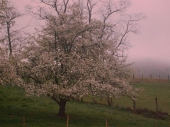




projects blog http://thekulaproject.tumblr.com
 1
1




 3
3








projects blog http://thekulaproject.tumblr.com

 2
2




List of Bryant RedHawk's Epic Soil Series Threads We love visitors, that's why we live in a secluded cabin deep in the woods. "Buzzard's Roost (Asnikiye Heca) Farm." Promoting permaculture to save our planet.




Bryant RedHawk wrote:
In France I have seen Apple trees that were pollarded every winter. These trees grow a Nob at the termination point of the trunk, from which all the new branches sprout in the spring, the varieties were all tip bearing trees.
I've never tried to accomplish this type of pollarding because it seems healthier, in my own opinion, for the tree to retain the main branches from a pruning session.
 2
2




Patrick Mann wrote:
For apples, my rule of thumb is you can prune anytime, except late fall if you have hard freezes in your climate that would freeze new growth. Summer pruning tends to dampen the trees regrowth response and is good for e.g. managing vigorous trees; winter pruning tends to stimulate growth and is good for less vigorous trees.
 6
6





|
I love the smell of tiny ads in the morning!
Rocket Mass Heater Resources Wiki
https://permies.com/w/rmh-resources
|

